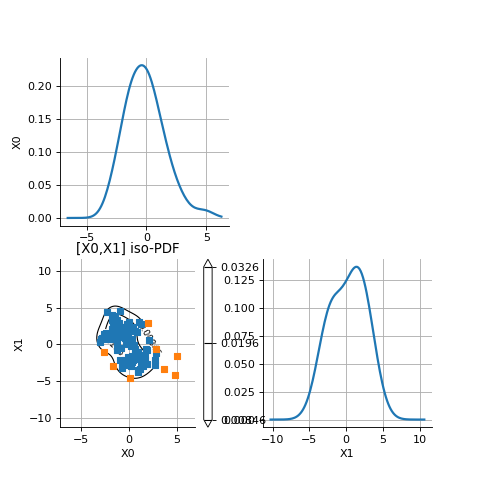MinimumVolumeClassifier¶
(Source code, png)

- class MinimumVolumeClassifier(*args)¶
Classifier define by a minimum volume level set.
- Parameters:
- mixtDist
Distribution A distribution.
- alphasequence of float, unique and sorted
Confidence levels
- mixtDist
See also
Notes
This implements a mixture classifier which is a particular classifier based on a minimum volume confidence domain.
The minimum volume confidence domain
is the set of minimum volume and which measure is at least
. It is defined by:
where
is the Lebesgue measure on
. Under some general conditions on
(for example, no flat regions), the set
is unique and realises the minimum:
. We show that
writes:
The classifier proposes 2 classes. The rule to assign a point
to a class k is defined as follows:
The grade of
with respect to the class k is
if
belongs to class k else
.
Examples
>>> import openturns as ot >>> R2 = ot.CorrelationMatrix(2) >>> dists = [ot.Normal([-1.0, 2.0], [1.0]*2, R2), ot.Normal([1.0, -2.0], [1.5]*2, R2)] >>> mixture = ot.Mixture(dists) >>> sample = mixture.getSample(1000) >>> distribution = ot.KernelSmoothing().build(sample) >>> algo = ot.MinimumVolumeClassifier(distribution, [0.8]) >>> algo.classify(distribution.getMean()) 0 >>> algo.classify([100.0]*2) 1 >>> sample = distribution.getSample(100) >>> graph = algo.drawSample(sample, [0, 1])
Methods
classify(*args)Classify points according to the classifier.
drawContour(alpha)Draw distribution contours.
drawContourAndSample(alpha, sample, classes)Draw distribution contour and classified sample.
drawSample(sample, classes)Draw classified sample.
Accessor to the object's name.
Accessor to the dimension.
Accessor to the distribution.
getLevelSet([j])LevelSet accessor.
getName()Accessor to the object's name.
Accessor to the number of classes.
Accessor to the threshold.
grade(inP, outC)Grade points according to the classifier.
hasName()Test if the object is named.
Accessor to the parallel flag.
setName(name)Accessor to the object's name.
setParallel(flag)Accessor to the parallel flag.
- __init__(*args)¶
- classify(*args)¶
Classify points according to the classifier.
- Parameters:
- inputsequence of float or 2-d a sequence of float
A point or set of points to classify.
- Returns:
- clsint or
Indices The class index of the input points, or indices of the classes of each points.
- clsint or
- drawContour(alpha)¶
Draw distribution contours.
- Parameters:
- alphasequence of float
Confidence levels
- Returns:
- graph
Graph The value of the density function defining the frontier of the domain.
- graph
- drawContourAndSample(alpha, sample, classes)¶
Draw distribution contour and classified sample.
- drawSample(sample, classes)¶
Draw classified sample.
- getClassName()¶
Accessor to the object’s name.
- Returns:
- class_namestr
The object class name (object.__class__.__name__).
- getDimension()¶
Accessor to the dimension.
- Returns:
- dimint
The dimension of the classifier.
- getDistribution()¶
Accessor to the distribution.
- Returns:
- dist
Distribution The distribution.
- dist
- getLevelSet(j=0)¶
LevelSet accessor.
- Parameters:
- iint
Index
- Returns:
- levelset
LevelSet The levelset defining the domain.
- levelset
- getName()¶
Accessor to the object’s name.
- Returns:
- namestr
The name of the object.
- getNumberOfClasses()¶
Accessor to the number of classes.
- Returns:
- n_classesint
The number of classes
- getThreshold()¶
Accessor to the threshold.
- Returns:
- threshold
Point The values
of the density function defining the frontier of the domain.
- threshold
- grade(inP, outC)¶
Grade points according to the classifier.
- Parameters:
- inputPointsequence of float or 2-d a sequence of float
A point or set of points to grade.
- kint or sequence of int
The class index, or class indices.
- Returns:
- gradefloat or
Point Grade or list of grades of each input point with respect to each class index
- gradefloat or
- hasName()¶
Test if the object is named.
- Returns:
- hasNamebool
True if the name is not empty.
- isParallel()¶
Accessor to the parallel flag.
- Returns:
- flagbool
Logical value telling if the parallel mode has been activated.
- setName(name)¶
Accessor to the object’s name.
- Parameters:
- namestr
The name of the object.
- setParallel(flag)¶
Accessor to the parallel flag.
- Parameters:
- flagbool
Logical value telling if the classification and grading are done in parallel.
 OpenTURNS
OpenTURNS